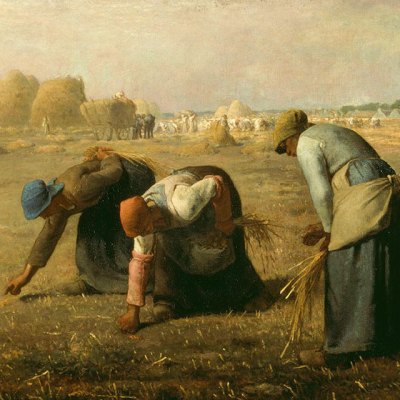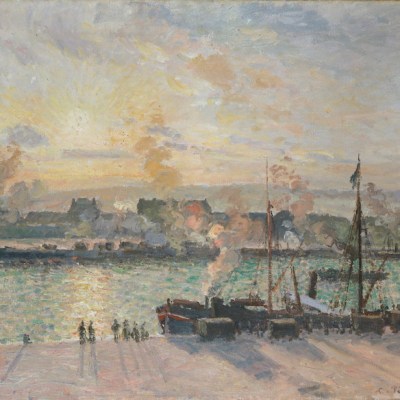

Haymakers Resting. (1891; detail), Camille Pissarro. McNay Art Museum, San Antonio; bequest of Marion Koogler McNay

‘Four things to see’ is sponsored by Bloomberg Connects, a free arts and culture platform that provides access to museums, galleries and cultural spaces around the world on demand. Explore now.
Each week we bring you four of the most interesting objects from the world’s museums, galleries and art institutions, hand-picked to mark significant moments in the calendar.
Born 195 years ago this week, Camille Pissarro is best known for his airy landscapes and outdoor scenes, but their pastoral sense of calm conceals the painter’s radical sensibilities. The ‘dean of the Impressionists’, as he was dubbed by the art historian John Rewald, harboured anarchist sympathies and saw art as a vehicle for social transformation. Throughout his career, Pissarro imbued rural workers with dignity; his paintings of field labourers, market vendors and peasant communities expressed his hopes for a more equitable society. For Pissarro, to paint villages was to paint microcosms of cooperative living, where humans maintained a harmonious relationship with their environment and each other.
Pissarro was far from alone in imagining utopian alternatives through art. From William Morris’s socialist craftsmanship to the revolutionary aesthetics of the Russian Constructivists, artists have long tried to imagine how labour might be reorganised to foster self-worth and satisfaction rather than exploitation. These visual utopias often emerge during periods of social upheaval – industrialisation, war, economic collapse – when the gap between reality and possibility becomes most painfully apparent. Whether depicting agricultural idylls or heroic industry, such works invite viewers to imagine worlds where human happiness is prized over profit. This week we explore four artworks that envision labour as a foundation for more equitable societies.

Haymakers Resting (1891), Camille Pissarro
McNay Art Museum, San Antonio
Three peasant women relax by a tree in a sun-dappled field, their work momentarily set aside. Pissarro renders them with densely woven brushwork that creates a luminous, almost reverent atmosphere. Unlike in many treatments of rural subjects, what is foregrounded in this oil-on-canvas work is not the poverty but the dignity of these figures. Their ease and conversation embody Pissarro’s ideals: labour balanced by leisure, social bonds and harmony with nature. Click here to find out more on Bloomberg Connects.

Potato Planters (1884), Vincent Van Gogh
Kröller-Müller Museum, Otterlodford
Figures toil in unison, a man and woman at the centre, their bent bodies arcing against a muted earth-toned landscape. Each figure mirrors the other’s posture, creating a visual harmony that suggests social equilibrium. Van Gogh’s portrayal of peasant life reflects both his admiration for rural communities and his concern about the encroachment of industrialisation on traditional ways of life. Click here to find out more.

Detroit Industry Murals (1932–33), Diego Rivera
Detroit Institute of Art
Massive fresco panels transform factory workers into monumental figures engaged in a choreography of industrial production. Rivera’s heroic labourers operate alongside machines rather than being dominated by them, their strength and purpose intact. While celebrating human ingenuity, Rivera also includes imagery that critiques the exploitative tendencies of capitalism. The murals synthesise traditional Mexican motifs with industrial imagery, suggesting technology keyed to natural harmony. Click here to read more.

The Ages of the Worker (1895–97), Léon Frédéric
Musée d’Orsay, Paris
A panoramic triptych traces the worker’s journey from childhood to old age, paying close attention to body language and emotional detail in a work that teems with detail. The central panel buzzes with the energy of youth, while the panels on either side show men engaged in physical labour and women raising children as equally vital forms of work. Click here to discover more.

‘Four things to see’ is sponsored by Bloomberg Connects, a free arts and culture platform that provides access to museums, galleries and cultural spaces around the world on demand. Explore now.

